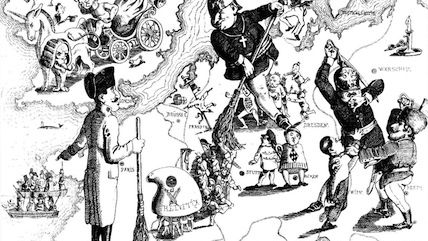Revolutionary Mice and Repressive Cats
Dissident movements learn from one another; so do the regimes they protest.


Dissident movements keep an eye on protests in other parts of the world, seeing which tactics seem to be working and then copying them at home. The governments being protested do the same thing, watching one another and imitating the most effective means of repression. And as this goes on, both the rebels and the rulers keep adapting, in what Jay Ulfelder calls "a bunch of interconnected games of cat and mouse, all happening at the same time":
Within each domain, each family of mice is busily trying to outwit its own cat, and each cat is diligently trying to catch its own mice. All the while, though, the cats and the mice are learning from what happens everywhere else—sometimes just by watching, but other times by talking and conspiring and even lending a hand. Often that aid passes from mouse to mouse or cat to cat, but sometimes it's the cat in one arena lending a hand to the mice in another, and vice versa. As communication and international organization get easier, the whole process only thickens and accelerates.
That's from a long, illuminating blog post in which Ulfelder, a political scientist, draws on everything from the color revolutions of the mid-oughts to the Occupy encampments of 2011. "For the sake of convenience (and, perhaps, sanity), social scientists usually think of the phenomena we study as occurring in independent 'cases,' which can be analyzed, compared, and contrasted as distinct and largely independent episodes," Ulfelder notes. "This independence, however, is often an illusion born of our need to simplify in order to understand. That's especially true for phenomena that involve rapid and deliberate imitation and adaptation." To see a suggestive effort to draw those not-so-independent cases together, you should read the rest of his post.
(Note: His post is from 2012. Still relevant in 2017, though.)
Editor's Note: As of February 29, 2024, commenting privileges on reason.com posts are limited to Reason Plus subscribers. Past commenters are grandfathered in for a temporary period. Subscribe here to preserve your ability to comment. Your Reason Plus subscription also gives you an ad-free version of reason.com, along with full access to the digital edition and archives of Reason magazine. We request that comments be civil and on-topic. We do not moderate or assume any responsibility for comments, which are owned by the readers who post them. Comments do not represent the views of reason.com or Reason Foundation. We reserve the right to delete any comment and ban commenters for any reason at any time. Comments may only be edited within 5 minutes of posting. Report abuses.
Please to post comments




That's actually pretty interesting and insightful.
Apt metaphor, as one of the problems of fighting oppressive regimes is that someone has to bell the cat.
More like the spooks running these "revolutions" constantly fine-tune their methodology and tactics.
What many people have trouble understanding, in my opinion, is that the oppressors usually are the ones handing the tools of oppression to the oppressed. When power shifts and the oppressed gain the upper hand, they almost immediately settle into being the oppressors using the same tactics and calling it revenge. And so the power swings, back and forth.
+ Sandinistas
Basically just describing intelligence. People being smarter than others opposing them.
The OWS protestors came in on the wrong side of that equation obviously.
And I am also working is here which is going to be here is nice to see Self Cleaning Litter Box Reviews